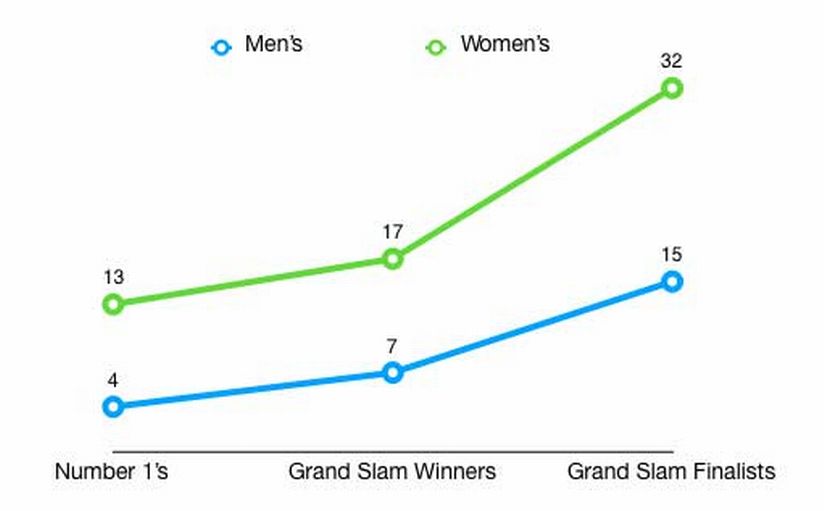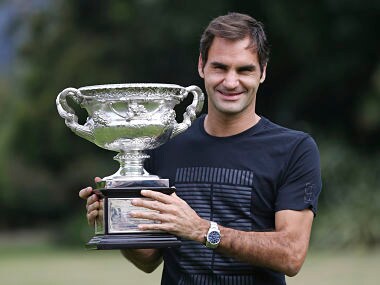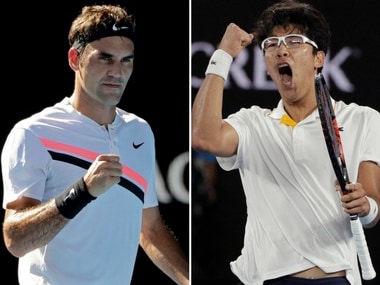Singles tennis has for long been considered a young player’s sport, especially in the men's draw. In the Open Era, with the advent of professionals competing at the Grand Slams, the peak age for player performance had hovered between the 24 to 28 year age-mark.
While this would have been true even five years back, a few players have recently made this theory fall flat on its face. Rafael Nadal is the sport’s oldest No 1, and Roger Federer has won three of the last five Grand Slam titles, and has a very realistic chance of usurping Nadal to become the sport’s oldest No 1, by a hefty margin.
The "Big Four" of Nadal, Federer, Novak Djokovic and Andy Murray have dominated the last decade or so and their competitors have shown little signs of slowing them down. While age will eventually catch up, and it’s showing already, the past decade (2008-17) has been era of daunting oligarchy at the top of the sport.
Women’s tennis, on the other hand, has had a very contrasting past decade. While the sport has historically been loaded at the top, with six players accounting for 50 percent of the Open Era Grand Slam titles (compared to the top nine winners for men), the 10 years gone by have had a sense of anarchy as to how the sport and competition have evolved. With a rush of young blood coupled with late bloomers, Grand Slams, unlike the men’s draw, have typically not had pre-ordained gatekeepers. We evaluate the last decade of competition at the top of the sport across the two genders here.
No 1s, Grand Slam winners and finalists
Only four men have held ATP’s top ranking in this period: Federer, Nadal, Djokovic and Murray. They also account for 35 of the 40 Grand Slam titles in this period. The WTA rankings paint a totally different picture on the other hand. There have been 13 WTA World No 1s in the same period, more than three times the number for men. This, despite Serena Williams having an Open Era record-equaling streak of 186 continuous weeks at the top.

Outside the Big Four of men's tennis, there have been three other Grand Slam winners, taking the total of men’s singles Grand Slam champions from 2008-17 to seven. The women’s draw has been way more competitive, with more than two times the numbers of winners, at 17. It’s not just true for the champions though, while there have been 15 male Grand Slam finalists, the number for women’s singles stands even taller at 32.
The age of the field
While the sport has historically favoured the young and peaking over the mature and waning, the current crop at the top of men’s tennis is an anomaly. The median age of the top-10 men (as of 29 January), is 26.5 with the oldest 1-2 duo ever. This age increases further as you go down to the top-32 (the typical seeds), standing at a median of 29. Fourteen out of the top-32 players are aged 30 and over.
On the women’s side, the numbers are more coherent with other individual, physically-demanding sports, as the median age for the top 10 is 24.5 and rises to 26 for the top-32. Compared to the 14 men, only nine women in the top-32 are aged 30 or over.
Grand Slam winners seed distribution
A seeded tournament bracket is designed to have a first vs second seed summit clash, at least theoretically speaking. What this essentially means is that the odds of the eventual winner being a top-two seed are high, thereby implying that the path to victory for lower seeds is that much more difficult. Given the protection the 32 seeds have in the first two rounds of Grand Slams, wherein no two seeded players can clash before the third round, the occurrence of unseeded Grand Slam Champions is almost mythical in nature.
However, there will always be anomalies, especially given the rather surprising nature of women’s tennis over the past decade. We have broken down the winners of the last 40 Grand Slams by their tournament seeds for both men’s and women’s draws, and the results are as contrasting as they can practically be. The brackets are seeds 1 and 2, seeds 3-5, 6-10, 11-32 and unseeded.
While the top two men’s seeds have accounted for 27 of the 40 Grand Slams, the number on the women’s side is much lower, at 17. The other end of the spectrum is even more contrasting; only two men not seeded in the top-10 have won a Grand Slam (one of them being Federer, seeded 17 at last year’s Australian Open), while in the women’s draw, there have been seven such occurrences, including three unseeded champions (including a wildcard entry for Kim Clijsters coming out of temporary retirement). Jelena Ostapenko, ranked 45th, and 83rd-ranked Sloane Stephens winning Grand Slams truly epitomises the volatility and the X-factor of women’s tennis: its depth!
The usual result can often be boring and the underdog story is always refreshing, and that has been the contrast in nature of men’s and women’s tennis over the last 10 years. The men’s draw usually presented a question of who among the Big Four would play the final, and the early rounds inherently felt like an official formality. The women’s draw posted more intriguing questions: ‘who will it be’; ‘will she even make it this far’; ‘how long can this young girl keep streaking?’ and so on.
Call it whatever you may, after a certain stage, oligarchy is overwhelming and anarchy can be nerve-wrecking and still fun!
Published Date: Feb 03, 2018 19:42 PM | Updated Date: Feb 03, 2018 19:50 PM




















